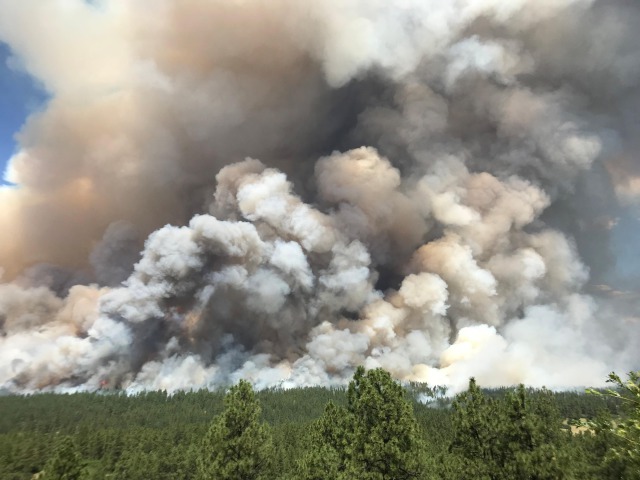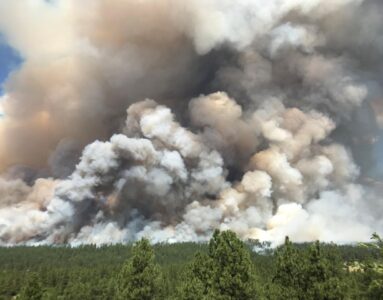Group working to prioritize public safety in federal fire policies
Date: Monday, October 16, 2023
Contacts: Sam Hitt, 505-577-2944, sam@wildwatershed.org and Peter Sorenson peter@sorensonfoialaw.com Available for a forest hike to see these issues.
Santa Fe, N.M—A lawsuit is being filed today by a coalition of conservation groups seeking information from the U.S. Forest Service on a project which began last week to burn and log over 50,000 acres near Santa Fe, NM. The lawsuit also seek documents related to last year’s devastating Hermit’s Peak/Calf Canyon fire near Las Vegas, NM. The lawsuit alleges that national and regional Forest Service offices violated the federal Freedom of Information Act (FOIA) by failing to provide any of the requested documents on threats to public safety and environmental impacts of its fire policies.
The information request was made June 28 by the Santa Fe Forest Coalition, a coalition of grassroots conservation groups based in Santa Fe, from the Forest Service Washington Office in Washington DC and the Southwestern Regional Office in Albuquerque, NM. No records have been provided despite FOIA’s requirement that federal agencies respond within 20 working days. The request for a quick turnaround was also denied. The requested information is needed to conduct an independent assessment of intentionally ignited fires that get out of control and destroy homes, acequia (irrigation) systems and livelihoods of struggling rural residents.
In addition to the lawsuit, a separate FOIA request was submitted today to the Santa Fe National Forest for information on the Santa Fe Mountains Landscape Resiliency project, the Santa Fe National Forest Land Management Plan and the intentional burn ignited in April of 2022 that escaped to become the Hermit’s Peak/Calf Canyon wildfire. The Santa Fe Mountains project would burn 38,000 acres, clear vegetation on 18,000 acres and do maintenance burns every five to 10 years. The Santa Fe National Forest Plan went into effect in 2022 and provides direction for the long-term management of the Santa Fe National Forest.
The requested information will help formulate a new twenty-first century federal fire policy that prioritizes public safety. The old policy from an earlier era is failing to keep the most vulnerable citizens safe during climate-driven wildfires. A more effective policy would provide low-interest loans, grants and technical assistance to rural residents to prepare their communities to resist destructive fires. Decades of research has shown that focusing on fire-safety home retrofits and the zone immediately around structures saves lives and protects property during wildfires. The tragic Hermit’s Peak/Calf Canyon fire resulted from the old policy that prioritizes reducing fuels over vast landscapes instead of focusing on protecting communities.[1]
This week the Forest Service plans to ignite a fire near the Hyde Park Estates despite the danger of flammable piles of debris and restricted access on the only escape route due to utility work on the Ski Basin road. According to the Forest Service, the risk is justified because of restricted times to conduct burns. Safe burning times are becoming increasingly rare because of the warming and drying climate in the southwest. However, even when done safely, prescribed burning and thinning are only effective when fire weather risk is moderate or low. This demonstrates the need for an updated fire policy focused on home hardening and localized fuel reduction.
“The mad rush to cut and burn is fueled by inflated budgets and a bureaucracy that puts the goal of meeting arbitrary targets ahead of public safety.” said Sam Hitt, president of the Santa Fe Forest Coalition. “We need a new fire policy that focuses on public safety. It’s ludicrous to burn next to a residential area surrounded by piles of flammable debris, with road construction blocking the only escape route. Instead of just meeting targets, public safety needs to be the first Forest Service priority.”
For more information see here.
###
[1] Treatments far removed from communities are ineffective because climate-drive fires rarely interact with treated areas. See Black, D., E. Barton, A. Rose, D. McKinley, and A. Dugan. 2022. Forest Carbon Assessment for the Santa Fe National Forest in the Forest Service’s Southwest Region. White Paper. 36p “. . . studies at large spatial and temporal scales suggest that there is a low likelihood of high-severity wildfire events interacting with treated forests . . .”

